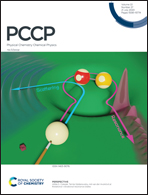Mn-Doped black phosphorene for ultrasensitive hydrogen sulfide detection: periodic DFT calculations
Abstract
This paper addresses the comparative detection capabilities of pristine (BP) and Mn-doped (MP1) black phosphorene sensors toward the noxious H2S molecule within a periodic density functional framework. The most stable configuration of the H2S molecule on MP1 preferred the placement of an S–H bond on top of the Mn dopant, while the H–S–H plane was slightly tilted with respect to the surface. The formation of the Mn-modified phosphorene sensor was found to be highly favorable (−3.79 eV), which also enhanced the stabilization of the H2S molecule (−0.85 eV at HSE06/TZVP). The electronic band structures revealed a direct-to-indirect transition and the observation of an n-type semiconductor through Mn doping. The results indicated that the pristine phosphorene could be converted into an ultrasensitive reusable H2S nanosensor in terms of both electric conductance (3747) and work function (11 times more sensitive) through Mn doping. The new sensor was also highly selective, with a sensitivity ratio of at least 52.6 with respect to the air components. The recovery time of the Mn-doped material (2.7 s at ambient temperature) was more promising than that of BP from a practical point of view. More discussion of the material is presented with the electronic properties, frontier molecular orbitals, and density of states at rest and under operating conditions.



 Please wait while we load your content...
Please wait while we load your content...